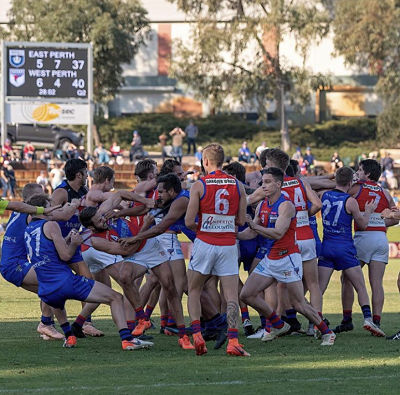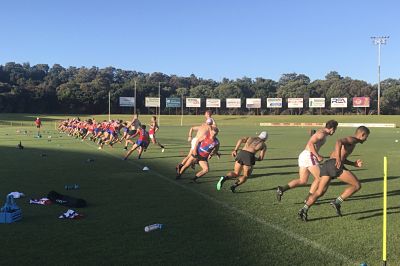Corey Green was a gifted Aussie Rules player with a promising future in his younger days but a serious ankle injury set him on a different career path as he's now the Managing Director of the Athletic Institute, which is home to the Precision Fuel & Hydration Sweat Test Centre in Perth.
A keen triathlete who's ranked in the top-100 in his age-group in Australia, Corey is also the Head Strength and Conditioning Coach at West Perth Football Club where he oversees all things performance.
With that in mind, we were keen to hear more about what endurance athletes can learn from the brutal sport of Aussie Rules...
G'day Corey, tell us how your injury setback set you on the course to being where you are today...
Hearing the words “you’ll never run again” was one of the hardest experiences of my life.
As a very competitive athlete growing up, I followed up that initial experience with the thought 'you can’t tell me what I can’t do' and made it a goal from that point on to prove the medical experts wrong.
It would take me 7 years to complete my first pain-free run.
Ultimately, if I didn't sustain that serious ankle injury, I would never have gone to University, started my business, or ignited a serious desire to become successful.
Athletic Institute was created so young athletes don’t make the same mistakes I did growing up, and we do that by educating, coaching and mentoring them to get better in all facets of performance.

Aussie Rules is renowned for being a brutal sport, so what’s the focus for you to help the players at West Perth minimise the risk of injuries?
In my opinion, Aussie Rules is up there as one of the hardest sports.
The key things I focus on are hamstring strength/mobility because of the frequency that players tend to suffer injuries to their hamstrings, as well as single leg strength, high speed running, nutrition, sleep and hydration.
The rehabilitation process is so important. I work alongside the club's physiotherapist to provide programs the athletes can handle while injured in order help them maintain strength and conditioning.
There is always something an athlete can do to keep fit, so there’s no excuse not to train during rehab.
Do you find your own personal experience of recovering from serious injury helps when working with an athlete during rehab?
My own experience with a serious injury helps with empathy and understanding towards their mindset and frustration, which makes me a better coach when helping them maintain motivation during a tough period.
Injuries will also reveal the true character of an athlete in some respects; the athletes with true desire have a few days of frustration, but back that up with the desire to get better and do the work.
Some athletes go the other way and throw their arms in the air and play the “it’s too hard” card; this is where I step in using my expertise and relationship with the athletes to find out what makes them tick, and guide them through the emotional phases of an injury.

And what would be your top-3 tips for avoiding overtraining?
Picking 3 is making this hard but see below for some key areas to focus on:
1. Use a training app linked to your Garmin/sports watch.
I prefer TrainingPeaks to look at chronic training load (fitness), fatigue (stress) and form (how prepared you are to perform).
I find so many athletes want to rush their results, which usually ends badly for them, so patience is key here
2. I’m going to cheat here and couple two together and say sleep and quality nutrition.
Aiming for 7-9 hours of sleep each night depending on your life schedule, and avoiding all refined foods when possible - aim for a lower carbohydrate, healthy fat and moderate protein balance.
I see so many athletes overemphasise the role carbohydrates play in day-to-day life and low intense activities.
Food is a fuel that should be used depending on exercise intensity, similar to hydration supplementation in different climates - modify your intake to the environment.
3. Consistency.
All too often, particularly at lower levels, athletes will have a good 3-4 weeks, followed by a poor 1-2 weeks, then try to pick up where they were a fortnight before.
This is a quick way to suffer load management issues, which could result in injury.
It’s better to pick a training load that’s realistic for your lifestyle, rather than trying to overcommit early on.
I like to get athletes to write down their usual working/training week, then I’ll plug in training days for them. Once an athlete proves they can sustain that, only then will I add additional sessions, and I have a saying I like to use with my athletes:
"Do the work, reap the rewards”.
I feel you have to earn the right to train more.
So, how do you put together a strength program that helps athletes get stronger but also remain functional for their sport?
For me, designing an athlete’s program is based on how they move but all sports have key focus areas which are non-negotiable. As I mentioned earlier, hamstrings and overall lower body strength is key.
A program will focus on key mobility areas (i.e. hips, quads, hamstrings, calves etc) for 8-10 minutes, followed by lower body strength lifts, usually coupled with an upper body strength exercise that involves lower body mobility/stability.

An example of this would be Barbell Bulgarian split squat (i.e. rear foot elevated split squat), coupled with a half-kneeling front foot elevated cable row to target hip mobility, T-spine rotation and down leg stability.
"Functional" for me is exposing the body to positions the athlete will regularly find themselves in, so we do a lot of spinal flexion/extension work, isometric quad/hamstring/calf work and spinal/knee co-contraction work.
How does the strength and conditioning work you prescribe for the players vary during the course of the season?
I normally will have 3 groups over the pre-season: athletes who need to either gain, maintain or lose size, so their programs vary depending on the group.
For example, athletes who need to increase muscle mass will have 3-4 gym sessions, as opposed to athletes who need to lose weight who will have 1-2 gym - plus 1-2 extra running - sessions.
During the season, most athletes will do 2 strength sessions to maintain power, and 1 high velocity running session.
Here's an example of an 'in-season' strength session:

And finally, what would be an ideal pre-match meal for an Aussie Rules player?
A great pre-game meal would be something like sweet potato mash with plenty of vegetables and protein of choice (i.e. chicken or fish).
For the vegans, plenty of plant-based carbohydrates with some greens.
I also encourage the players to pre-load with electrolytes the night before using PH 1500.
Thanks Corey!
To find out more about Corey's work at the Athletic Institute and to book in for an Advanced Sweat Test, visit www.athleticinstitute.com.